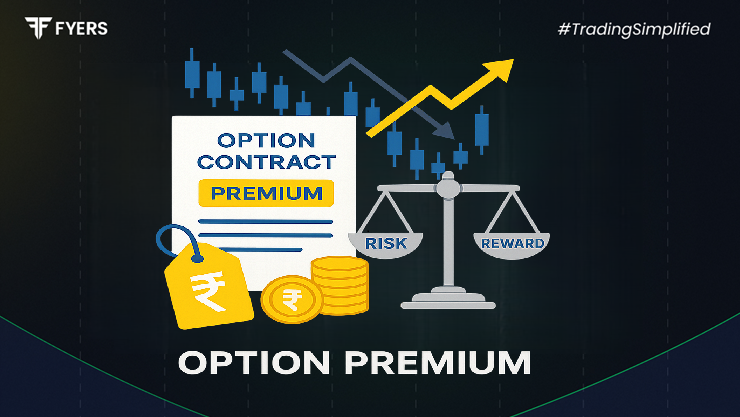

 23 Sep, 2025
23 Sep, 2025
 3 mins read
3 mins read

Options are a popular derivative instrument in the stock market, allowing traders to hedge risks or speculate on price movements. To enter an options contract, the buyer pays a cost to the seller. This cost is known as the option premium.
Understanding how this premium works and what factors affect it is crucial for anyone interested in options trading.
The option premium is the price an option buyer pays to the option seller (also called the writer) to acquire the right, but not the obligation, to buy or sell the underlying asset at a fixed strike price before or on the expiry date.
In simple words, it is the cost of holding an options contract.
For the buyer, it is an upfront expense.
For the seller, it is the income earned for taking on risk.
The premium in option trading is made up of two parts:
The amount by which an option is in-the-money (ITM).
Example: If a stock trades at ₹550 and a call option strike price is ₹500, the intrinsic value is ₹50.
The extra amount buyers are willing to pay, anticipating future movements before expiry.
Longer the time to expiry, higher the time value.
Thus,
Option Premium = Intrinsic Value + Time Value
Several factors influence the premium price:
Underlying Asset Price – As the stock price moves closer to or beyond the strike price, premiums rise.
Strike Price – Options closer to the current market price (at-the-money) generally have higher premiums.
Time to Expiry – Longer durations mean more time value, increasing the premium.
Volatility – Higher expected price swings increase premium since the probability of profit rises.
Interest Rates & Dividends – Changes in interest rates or expected dividends can impact option pricing slightly.
The option premium calculation is typically done using models like the Black-Scholes Model or the Binomial Model, which take into account the above factors.
At its core:
Option Premium = Intrinsic Value + Time Value
Call option strike price: ₹580
Intrinsic Value = ₹600 – ₹580 = ₹20
Assume Time Value = ₹10
Option Premium = ₹20 + ₹10 = ₹30
So, the buyer pays ₹30 per share to hold this option contract.
While strike price is the predetermined level at which the option can be exercised, the option premium is the cost to acquire that option.
Strike Price: A fixed contract term decided when the option is created.
Premium: A variable amount that changes with market conditions.
Both are closely linked—strike prices influence how much premium a trader is willing to pay.
Understanding option premiums is essential for traders because:
It determines the entry cost for buyers.
It provides income for sellers (writers).
It helps assess risk and reward before entering a trade.
It is a key element in strategies like spreads, straddles, and hedging.
By evaluating premium changes, traders can better plan their strategies and manage risk effectively.
The option premium is at the heart of options trading. It reflects both the intrinsic value and time value of a contract, and is influenced by several market factors like price, volatility, and time to expiry.
For option buyers, it represents the cost of potential opportunity, while for sellers, it serves as compensation for risk. Knowing how to calculate and interpret option premiums can help traders make more informed decisions and build effective trading strategies.
It is the price paid by the option buyer to the seller for holding an option contract.
Option Premium = Intrinsic Value + Time Value. Models like Black-Scholes are also used for precise calculations.
Underlying price, strike price, time to expiry, volatility, interest rates, and dividends.
Options closer to the current market price (at-the-money) or in-the-money usually have higher premiums than far out-of-the-money options.
Calculate your Net P&L after deducting all the charges like Tax, Brokerage, etc.
Find your required margin.
Calculate the average price you paid for a stock and determine your total cost.
Estimate your investment growth. Calculate potential returns on one-time investments.
Forecast your investment returns. Understand potential growth with regular contributions.